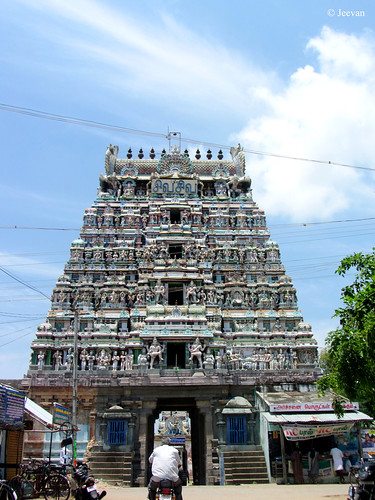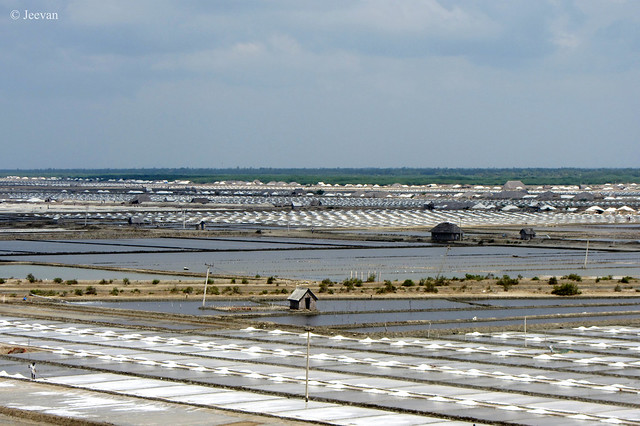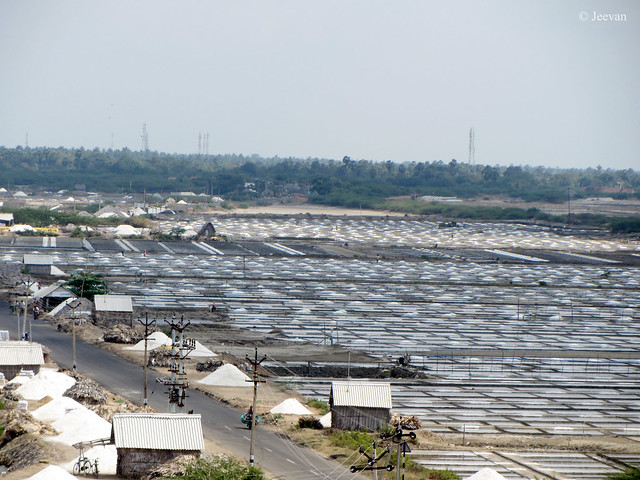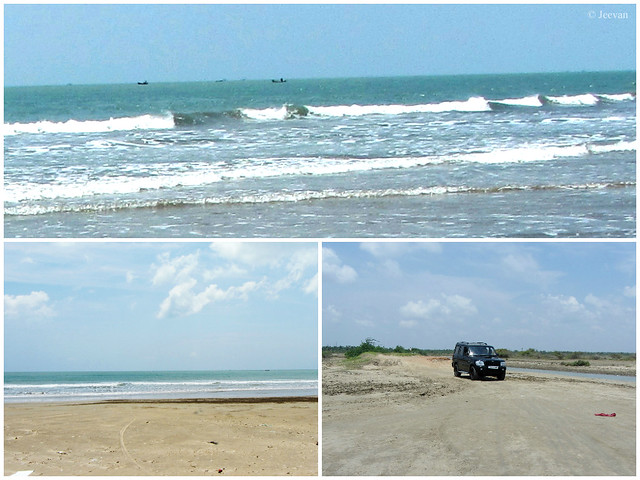| British Light House |
| Chola Lighthouse ruin |
| Isolated at a pristine beach, Point Calimer |
| British Light House |
| Chola Lighthouse ruin |
| Isolated at a pristine beach, Point Calimer |
 |
| Vedaranyeswarar Temple Tower (click photos for enlargement) |
 |
| Salt Pans of Vedaranyam |
 |
| Salt Pans along the way to Point Calimere from Vedaranyam |
 |
| Vedaranyam Beach |
It's been ten years since I visited Kodikkarai (aka Point Calimere), yet the memories are still vivid in my mind. Furthermore, the novel I am currently reading, Ponniyin Selvan, has a lot of connection with the place in its second and third volume, which overlaps with the time of my visit, precisely ten years ago.
Ponniyin Selvan is a renowned classic historical novel in Tamil written by Kalki, which needs no introduction if you come from Tamil Nadu, the southern state of India. As captivating fiction, the novel tells the story of the greatest king, Raja Raja Chozan. I love reading this book, or more accurately, I enjoy traveling through it, and Kodikkarai is one of the key stops on this journey; that transports me through nostalgic memories and into a thousand-year-old fantasy.
 |
| At the pristine shore of Kodikkarai |
I envisage a dense forestation once in the already widespread scrub forest of Kodikkarai, home to many blackbucks and chital deer, wild horses, boars, and foxes, where the courageous Vanthiya Devan follows the insane girl Poonkuzali, who tricks him and saves him from quicksand.
Kodikkarai is a vast network of backwaters that includes the Great Vedaranyam Swamp and the Cauvery Estuary; it opens up to dry evergreen forests, mangrove forests, and wetlands where quicksand is common.
Based on their discussion in the book, I can imagine how wild it should be to have tigers and leopards in the Kodikkarai forest a thousand years ago. They used to say that where there are deer, there will be tigers, but now in Kodikkarai, the deer are safe from everything but the cunning foxes.
 |
| The 9th Chola lighthouse ruin was surrounded by water during high tide. |
While I sat along the pristine and powdered sand shore of Kodikkarai, besides a half-cylindrical ruin of the Chola's brick and mortar lighthouse, I had no idea that I was sitting at a historical landmark of the Chola dynasty. And that our Ponniyin Selvan (Raja Raja Cholan) arrived in Sri Lanka from here.
About a thousand years ago, the Chola lighthouse was a tower-like structure where firewood is lit atop the tower to indicate the ships and warn about the shallow seashore.
Ponniyin Selvan is a 5-volume novel, and I've finished the first two and am now reading the third, which seems to be more intense and all pointing towards Kodikkarai; my imagination is taking new sights and vistas of the shore. The Kadikkarai coastline is shallow for a few kilometers and has stripes of sandbanks to keep ships away, and only tiny boats can access.
It was a magnificent sight to see hundreds of birds take off and land on a sandbank by the sea, as well as a herd of deer leap across a long stretch of ground and disappear into the bushes. It was a scene that struck my mind's vision like a flash of lightning forever. The forest department permitted safaris within the forest up to the Chola lighthouse to watch the wildlife.
Kodikkarai is a nearly right-angle turn in Tamil Nadu's coastline in the delta region of Nagapattinam. It houses wildlife, a bird sanctuary. Kodikkarai is a 10-kilometer drive from Vedaranyam and takes us past extensive salt pans on one side and woodland on the other.
 |
| A white heron taking off |
Every winter, millions of birds from all over the world visit Kodikkarai, and it is popularly known for the Greater flamingo. During our trip to Kodiyakkarai, we stayed at the forest guest house, close to the forest and the new lighthouse. And the suite allotted for us is named "Flamingo."
It was a beautiful experience to see deer and peacocks casually roaming around the guesthouse, and the rattle of peacocks was a rhythmic way to wake up in the morning. Since the guesthouse had a tile roof, we heard knocks at night, which was nothing but peacocks who enjoyed a stroll on the roof.
Unfortunately, I could not share many photos from Kodikkarai, as I have saved the photos on DVDs, my new laptop doesn't have a DVD drive. Some of these photos are from my archiver, and those remained on the hard disk I have many photos of the wildlife, the beach, and the forest to share with you, but you'll have to wait till I buy an external DVD driver.
| The old lighthouse |
| A beautiful blue yacht, beneath the blue sky over the blue sea |
| Beach boys |
| A Brahminy Kite or Red-backed Sea-eagle flight over the sea |
Foxes and Jackals have become an endangered species in our Indian subcontinent, and I remember seeing a Jackal (in wilder) only once in the Kodiakkarai scrub forest, aka Point Calimere. I have been to many wild forests, but nowhere I could see a Fox or Jackal. It seems the foxes have almost lost their habitation, and who could be responsible for that other than us, the human beings?
Man hunted foxes/jackals for their skin and flesh - believing to have medical values is used in traditional medicine is one of the reasons for the foxes to disappear from the forest. And those who hunt foxes are called Narikuravar (fox tribe) in southern India, and they sell things made of fox body parts, esp. they make necklaces with fox tooth hanging.
But they stopped hunting fox/jackals after the Indian Wildlife Conservation Act (1972 as amended to 2005) forbids the hunting of all wildlife; they were prohibited entry into the forests; thus took alternatives such as selling beaded ornaments to survive. But beyond that, habitat loss is the main reason for the fox/jackal to become endangered. The conversion of grassland habitat to agriculture, industry, and increasingly bio-fuel plantations have drastically affected its population.
There is an attitude of comparing fox/jackal trickery and ingenuity with people among us, who are very sharp, specific, and self-centered. There's a famous story of The Fox and Crow told in various versions (and ours was "granny's vada"); to praise the trickiness of fox, but the moral of the story was to never deceive anyone cunningly for our benefit and don't believe everyone's word.
There is also a superstition in India that waking up on a fox face or hearing a jackal howl means good things will happen. And there are much folklore, mythology, and literature relevant to the jackal's cunningness and religious beliefs. So whatever it is, preserving a dying species is everyone's duty, and those living around the forest need to be more responsible, emphasizing the same.
The golden jackal I shared here was shot at Amirthi Zoological Park, near Vellore. The Park has a nice set of dens, that too a colorful one - paintings of trees resembling the walls of the kindergarten - covered by a partial dome-like cage. When we visited, a lone jackal was roaming outside the dens - there are two separate dens, what I guess was there must be at least a pair of jackals - right now, only one is available.
The Golden Jackal, believed to be a social animal that lives either as pairs or packs like wolves, is native to Southeast Europe to Southeast Asia. Comparatively, a small size wolf, "the jackal possesses shorter legs and a shorter tail, a more elongated torso, a less-prominent forehead, and a narrower and more pointed muzzle. The golden jackal's coat can vary in color from a pale creamy yellow in summer to a dark tawny beige in winter."
"The genetic studies indicate the golden jackal expanded from India around 20,000 years ago, towards the end of the last ice age. Golden jackals' habitat in valleys and beside rivers and their tributaries, canals, lakes, and seashores feed on foods ranging from fruit and insects to small ungulates." (courtesy wiki)